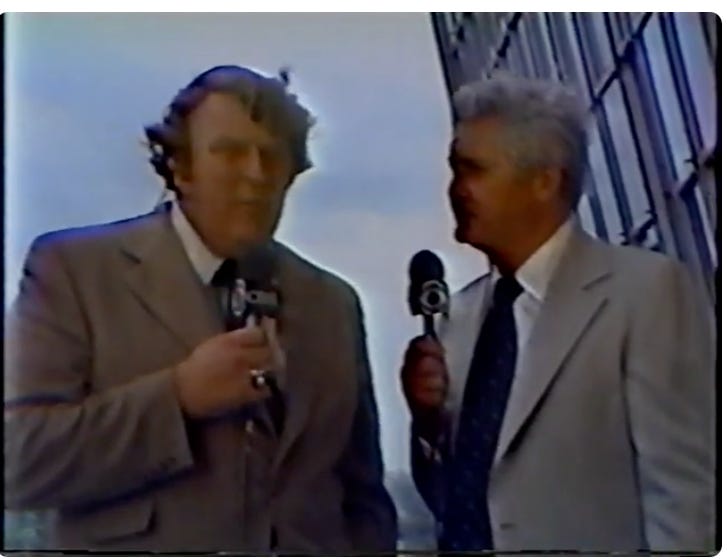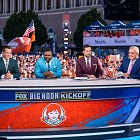Pat Summerall, Joe Buck, and the Lost Art of Shutting Up (1979)
This is Throwbacks, a newsletter by me, Michael Weinreb, about sports, history, culture, and politics—and how they all bleed together.
If you like what you read, please click the button below, join the mailing list for FREE and please share, on social media or through e-mail or however you feel comfortable sharing.
And if you’ve been reading for a while, please consider joining the list of paid subscribers to unlock certain posts and allow me to expand Throwbacks’ offerings.
Click here and get 25 percent off your subscription for the first year.
(If you cannot afford a paid subscription and would like one, send me an email and I’ll comp you one, no questions asked.)
I.
Forty-six years ago this month, on November 25, 1979, the Tampa Bay Buccaneers played what was then the most crucial game in the short and ignominious history of the franchise. The Bucs were 9-2 and on the verge of making the playoffs for the first time ever, but honestly, none of that context really matters, because this was by far the most memorable thing about that Bucs-Vikings game:
Pat Summerall was a former NFL kicker turned play-by-play broadcaster. He was also an all-star drinker and carouser who had spent much of his career calling games with Tom Brookshier, another dude who knew how to have a good time. CBS executives were tired of Summerall and Brookshier tearing up the bars in every city they parachuted into, so they decided to experiment with a new pairing: They set Summerall up with John Madden, the former coach of the Oakland Raiders, based in part on Madden’s work in a series of Miller Lite commercials.
Madden and Summerall were apparently tasked with doing their first-ever pregame hit on the roof of the Nakatomi Building. But once they settled into the broadcast booth, it became clear that they had an almost preternatural chemistry.
The first thing you notice while listening to that game (if you can get past the O.J. Simpson screenshot), is just how subdued Madden was. This was before the telestrator, before the turkey legs, before the All-Madden team, before Madden became a character worthy of a manic David O. Russell biopic. But let’s forget about Madden for a moment, because enough has been said and will be said about him; let’s turn our focus, instead, to the minimalistic brilliance of Pat Summerall.
Two remarkable things occurred in the final moments of this Bucs-Vikings game: First, Bucs quarterback Doug Williams scrambled and hurdled a defender for a spectacular 13-yard touchdown. Here is how Summerall called it:
Williams under pressure…comes out of the pocket…Williams to the five…Williams touchdown.
That made the score Vikings 23, Bucs 22. Moments later, the Vikings leapt up and knocked down the extra-point try. Here is how Summerall called it:
Blocked! The Vikings block another one. And lead by one. It’s 23-22, Minnesota.
Soon enough, Summerall and Madden would be paired together every week, and they would become the most iconic broadcasting tandem in NFL history, because their personalities meshed more ideally than any broadcasting tandem ever has.
It is an odd thing to listen to Pat Summerall in this day and age. (Honestly, it was an odd thing even back then; the first time I heard his deadpan touchdown delivery when I was a kid, I remember wondering if he was playing a joke on his audience.) You can find Madden’s influence everywhere these days, both for better and for worse. But it now seems clear to me that Summerall was far more underappreciated, and also had the far more difficult job: He managed to tell the story of a violent and cacophonous sport in the most restrained manner one could ever imagine.
II.
A couple of weeks ago, I wrote a column about the Fox college football broadcaster Gus Johnson, who is everything that Summerall was not. A number of people agreed with me that Johnson is an absolute albatross of a broadcaster when it comes to big games; but a few people did not agree. Normally I am not one to spend much time demeaning broadcast crews, particularly for some perceived “bias” that doesn’t exist (and even if it did, how would it actually affect the game itself?) But like anyone who watches sports regularly and constantly, I do think a lot about how broadcasters make us feel; I think about how so much of this is wrapped up in our own nostalgic attachments, and how these voices evolve over time as the culture begins to shift.
I think that’s what I was trying to get at with Johnson:
Keep reading with a 7-day free trial
Subscribe to Throwbacks: A Newsletter About Sports History and Culture to keep reading this post and get 7 days of free access to the full post archives.



